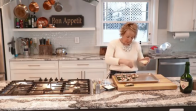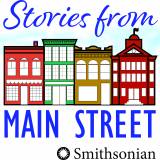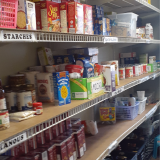Bowen's Inn History and Food, Maryland
Story Narrative:
Gwyn and Donald Novak talk about traditional seafood cooking in Maryland and how they've adapted to changes in their industries as a chef and waterman. After the historic family business Bowen's Inn burned down in 2006, Gwyn started the cooking business No Thyme to Cook and she shares local recipes for Oysters Rockefeller and crab cakes. Donald demonstrates how to shuck an oyster and talks about the decline of fish in the Chesapeake Bay. Cora Cotson, Andrew Humphereys, and Keilani Butler from Michelle Stover's English class at Calvert High School document this ocean-to-table business and the Novak family legacy at Bowen's Inn, while exploring the changing seafood industry in the Chesapeake Bay.
Find the complete transcript at the bottom of this page.
Speaker 1: Along the Chesapeake Bay waterways there are multiple restaurants that sell and provide seafood dishes to the general public across Maryland and Virginia. Amongst all one restaurant in particular caught people's attention from along the DC metropolitan area for their well known crab cakes and fried chicken, Bowen's Inn Known for its hotel, restaurant, bar and Marina. It quickly became one of the top spots for fishers, congressional and sports figures from Washington DC. Important people such as Arthur Godfrey, Harry Truman, Robert Mitchell, and even the 35th President of the United States, John F. Kennedy, have eaten here. Making Bowen's Inn popular throughout the years in the DC, Maryland and Virginia tri state area.
Speaker 1: [0:41] Starting up in 1918, Bowen's Inn was a popular tourist attraction. Well known for its cheap drinks and lively bands. Sitting next the claim then was the infamous lighthouse and both well-liked by Marylanders and tourists alike. While one was known for the live shows and drinks, the other boasts of the skip check-in and the boat bar with an amazing atmosphere and beer. Yet Sadly on Wednesday, March 15th, 2006, a blazing fire fueled by 40 mile per hour winds took out the landmark in just under two hours. It took over 50 firefighters and a few tugboats to finally clear the fire, but by then, the damage was done. Bowen's Inn was no more.
Speaker 1: [1:16] The historic establishment which would had stood since 1918 have been wiped off the face of the earth. 12 years later, after the fire on May 18th, 2018, the great granddaughter of Mortimer Bowen, Gwyn Novak established a small cooking class business with her husband Donald called, No Thyme to Cook. As a native Southern Marylander, Gwyn wanted to be able to continue creating great food and spirit hospitality like her family did years ago throughout the community.
Gwyn: [1:41] So I'm Gwyn Novak, and I'm the chef and owner here, at No Thyme to Cook. I started No Thyme to Cook after I'd been out of cooking school for a number of years and worked in restaurants and catering companies. And I just did not love the same thing day in day after day that you often get in a restaurant. So, I started No Thyme to Cook as a personal chef service. That was great, great business, until the economy kind of tanked back in '08. And oddly enough, the first thing that people cut out of their budget was the chef, believe it or not. And so I took a little hiatus and then about six years ago, I started teaching cooking classes. And then within the last year, it's turned into this beautiful building.
Speaker 1: [2:18] In Maryland, one of the most popular dishes is oyster Rockefeller. With Gwyn Novak, having a husband that is a Waterman, she usually gets fresh flushes of oysters for the meal she prepares for cooking classes, watches her husband share the art of shucking oysters.
Donald: [2:33] How do you shuck an oyster? An oyster is pretty simple by design. It has a hinge and a bill. Traditionally, the way to shuck an oyster is bill first, you shuck it through the bill. Some people attack it from the hinge and pry it open, but I use a traditional shucking knife, then blade, pointy and sharp, in through the bill, you find the muscle on one of the shells, it's attached to, I don't know if you can see it, but it's attached right there. You can see that? Once you get the knife blade in, and cut that muscle, he's done. It'll pry right open 'cause the whole oyster is basically just muscle on this side muscle on the other side. That's all it is. And when you cut one side, he can't hold the shell together anymore. Pry him open cut the other side and he's done. That's it. It's that simple.
Speaker 1: [3:33] Now that we know how to properly shuck an oyster, Miss Novak will demonstrate how to make oyster Rockefeller.
Gwyn: [3:39] What we have is some bacon, we have some cheese, we have some butter, we have some Sherry, and some thyme and salt and pepper. So what I'm gonna do is, I kind of pack cook these a little bit, meaning partially cook them, so that by the time the other things cooked, the oysters wouldn't still be raw. So we're gonna do is add a little bit of butter first of all 'cause I think everything's been with butter and bacon. You can use salted or unsalted butter, it's your call. And then I'm gonna give it a splash of Sherry. This is also really good to do with brandy, cognac.
Asset ID: 8567
Themes: Water, waterways, cooking, Key Ingredients, food, Chesapeake Bay, fishermen
Date recorded: 2019
Length of recording: 15:32 m
Related traveling exhibition: Water/Ways
Sponsor or affiliated organization: Calvert County Library and Bayside History Museum
More information: https://www.thebaynet.com/articles/1018/calvert-library-students-join-up-for-smithsonian-project.html




